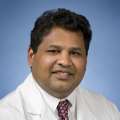Two interventional endoscopists at the are conducting research addressing key challenges in the diagnosis and management of Barrett’s esophagus (BE).
The issues include which patients to screen, how to identify the condition in a more timely manner, and how to better predict which patients found to have BE will progress to esophageal cancer and thus should be treated immediately with endoscopic eradication techniques.
Approximately 16,000 people die of esophageal cancer in the U.S. each year, and because most diagnoses are of patients with late-stage disease, it continues to be associated with high mortality.
As the only identifiable esophageal cancer precursor lesion, “Barrett’s provides an opportunity for early identification and enrolling patients in surveillance or treatment programs for dysplasia associated with the condition,” notes health sciences assistant clinical professor of medicine in the UCLA Vatche and Tamar Manoukian Division of Digestive Diseases, where the Kardashian Center is based.
“But we know that even with our best risk stratification tools, we fail to recognize a large number of patients,” Dr. Kolb adds. “And so, unfortunately, many people still present with esophageal cancer without a prior Barrett’s diagnosis.”
Current guidelines call for high-risk patients to undergo endoscopic screening for BE and cancer. Patients are generally screened when three or more of the following risk factors are present: being Caucasian, male, obese, older than 50, a current or former smoker, having chronic GERD, and having a family history of BE or esophageal cancer.
When BE is diagnosed, typically endoscopic eradication therapy is recommended for patients with high-grade dysplasia or early cancer, with esophagectomy reserved for cancers that are not endoscopically treatable. For low-grade dysplasia, both endoscopic therapy and surveillance are appropriate options; non-dysplastic patients generally undergo surveillance at regularly scheduled intervals.
“For most conditions, first we come up with good ways to diagnose and manage it, and then finding a cure takes more time,” says clinical professor of medicine in the division and director of interventional and general endoscopy for UCLA Health. “Barrett’s is unusual in that, with our endoscopic eradication therapies, we’re way ahead on the treatment side, but we have a lot more work to do upstream in finding patients with the disease and predicting who will progress to dysplasia or cancer.”
Challenges in the field
Dr. Muthusamy explains that the challenge in the BE field is threefold:
- For the majority of cases, the precursor lesion isn’t identified prior to the patient presenting with cancer.
- For individuals under surveillance, biopsies don’t always successfully detect abnormal areas.
- In patients with known BE, the vast majority will never progress to cancer, but it’s not generally known which patients should be treated as opposed to being placed under regular follow-up.
Efforts are underway to leverage the electronic health record — potentially with the assistance of artificial intelligence or machine learning — in ways that will better identify at-risk patients for screening, Dr. Kolb notes.
But as more people become screening candidates, upper endoscopy involving large numbers of patients isn’t necessarily feasible, suggesting the need for increased use of alternative modalities such as trans-nasal endoscopy or cell collection devices relying on biomarkers.
“We know that for colon cancer screening, there is a menu of choices,” Dr. Kolb says. “And as we start to think about alternative screening modalities for Barrett’s, we need to better understand patient preferences.”
Dr. Kolb and her colleagues recently received funding for a conjoint analysis looking at patient preferences regarding test attributes. Through a questionnaire given at a primary care clinic to patients at risk for BE but not yet diagnosed, her group is raising awareness about BE and esophageal cancer, then asking patients what test options they would prefer and their threshold for taking part in screening.
Dr. Kolb also received the prestigious ACG Junior Faculty Development Award from the American College of Gastroenterology — a highly competitive three-year grant supporting a junior faculty member of outstanding promise.
Approximately one-fourth of non-dysplastic patients who are receiving routine upper endoscopy as part of surveillance present with cancer before they are scheduled to return. Dr. Kolb’s project investigates the role of post-endoscopy esophageal adenocarcinoma or neoplasia (PEEC/PEEN) detected after a negative upper endoscopy but before the next recommended exam.
“These cases are thought to represent failed detection of Barrett’s-related neoplasia or rapidly progressive cancer,” Dr. Kolb notes. Her study will determine the frequency of PEEC/PEEN along with the determinants of these cases, and will develop an evidence-based, multilevel implementation strategy to prevent PEEC in clinical practice.
Multicenter trials
Under Dr. Muthusamy’s leadership, the Kardashian Center is part of two large multicenter BE trials. One compares the efficacy of a special brush versus traditional biopsy methods in sampling the tissue of BE patients who are under surveillance for the development of dysplasia.
“We are looking at whether this brush samples more broadly than taking a biopsy in a prescribed pattern, and could be a more cost-effective approach,” Dr. Muthusamy says.
A second trial compares two options for the management of patients with low-grade dysplasia: immediate treatment with endoscopic eradication therapy versus observation with surveillance biopsies and intervention for those who progress to high-grade dysplasia.
Patients at the Kardashian Center benefit not only from a multidisciplinary team of experts and support staff, but also from UCLA’s long record of leadership in research on BE and other esophageal conditions.
Dr. Muthusamy was instrumental in introducing the use of radiofrequency ablation to burn off the dysplasia in patients with Barrett’s — an approach that has become the preferred treatment modality — and continues to study and refine innovative new techniques. The UCLA interventional endoscopy group is also part of the nation’s largest actively maintained database of BE patients, tracking success rates and long-term outcomes of patients treated with resection and endoscopic ablation therapies, as well as those followed in surveillance programs.
“As we broaden our screening strategy to try to prevent late-stage cancer, we are going to see a large influx of patients with a low-risk Barrett’s diagnosis,” Dr. Kolb notes. “By coming up with better ways to understand patients’ risk of progression, we will move toward a more precision medicine approach in which we can individualize surveillance and treatment plans.”





